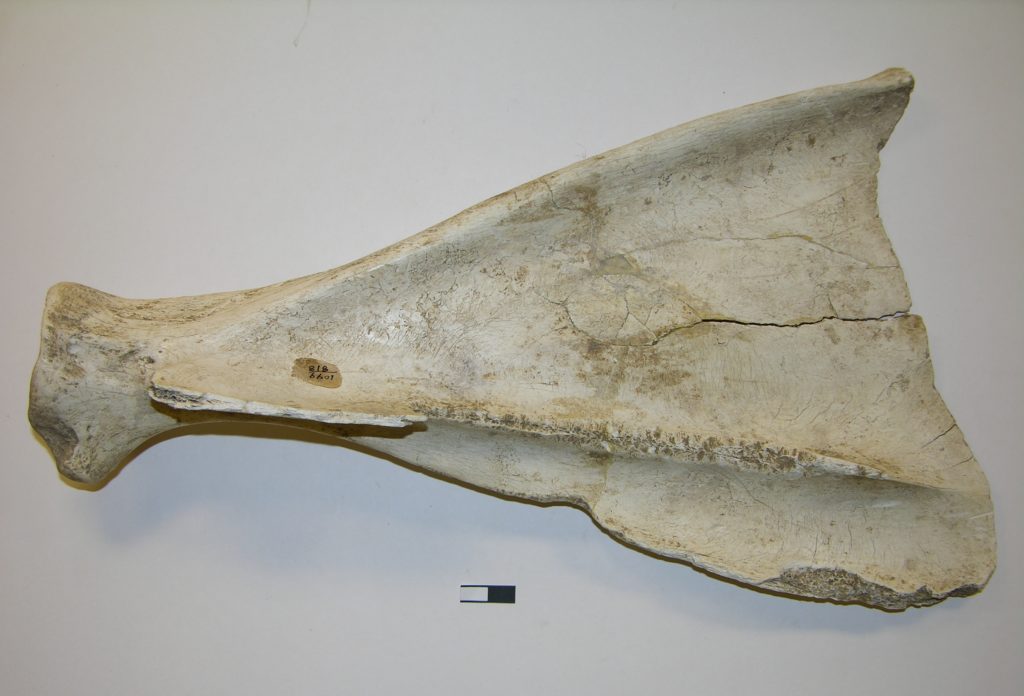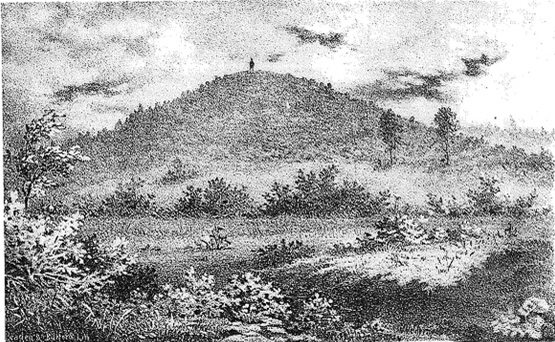Native Americans
Historical records suggest bison were numerous in southern Indiana, but their remains are very scarce. Only two archaeological sites with more than a few skeletal elements reported as bison have been documented. These are located near Rockport in Spencer County and their association is with 18th century Euro-American campsites established on the river bank. There are only a few scattered elements of bison bone identified from Mississippian period Caborn-Welborn phase sites in southwestern Indiana and others in Kentucky. There are also a few bones identified as bison from Oliver phase sites and some of them were modified into tools. The hoe made from a bison shoulder blade below was found at an Oliver phase village in central Indiana. It is heavily worn from use on the broad end. A bony ridge has been mostly chipped away to tie the blade to a handle.

The shoulder blade, or scapula, of the bison was used by Native Americans from the Plains to Indiana as raw material for a hoe blade. The joint or acetabulum was usually cut off, as was the spine, making a thin, flat, trapezoidal shape that was then attached to a long handle. Hoes would have been used to weed corn fields and garden plots.

So far, we have no evidence of prehistoric bison kill sites in Indiana or the surrounding region. Dried meat, hides and bones for tools could have been readily traded far from sites where bison were killed and butchered. A major problem is that the skeletons of modern cattle, oxen, and bison are difficult to distinguish without skulls and other key elements. In addition, when skeletons are incomplete and fragmentary, the individual bones of elk and other large game can be also confused with bison.
In the view shown below of a surviving section of the Buffalo Trace, now heavily forested, countless animals, prehistoric people, soldiers, American settlers, and travelers passed through southern Indiana using this natural road through the wilderness.

We do not know why bison began regularly crossing south-central Indiana, nor do we know when this change in migration pattern first began. The Falls of Ohio was a crossing for migrating bison and humans, as well as a portage and destination for prehistoric river travelers back thousands of years. Part of the bison trace does cross the “barrens” of Harrison County that was largely treeless when the pioneers first came to the region. Grasslands near and along the trace are also documented by the original land surveyors north of New Albany in Clark County. These and other patches of grassland apparently persisted throughout prehistory and may have been first maintained by the feeding habits and movements of mammoths, mastodons, and possibly prehistoric man that, much later, became an attractive grazing avenue and trace for the annual migrations of bison. Bison remains from the Rockport sites and others from historic and late prehistoric sites should be included in a larger study to clarify the identification of bison remains and the archaeological evidence for prehistoric utilization of bison in the Midwest. Such a research project should include archaeological surveys in the vicinity of Buffalo Trace features, attempt to reconstruct the natural history and migration patterns of bison east of the Mississippi River, and also address late prehistoric aboriginal food preferences and hunting practices in Indiana and surrounding states with regard to bison. [1]

A place of interest to early settlers related to Native Americans which was noted by many early travelers was the Pyramid Mound site near Vincennes, Indiana. It was originally described by Collett (1874) as being oblong, about 300 feet long, with a level area on the top (see photo from 1874 with the figure of a man at the top of the mound). The mound is decently preserved, as no systematic archaeological investigations have taken place at the site. Patton (1874) performed some limited excavations in 1874, which led to the discovery of Native American burials.[2] Due to the lack of excavations at the site, very little is known about the people who used the mound. It is thought that the site dates at least to the Mississippian period, based on a single Yankeetown pottery vessel.
The mound is a natural loess hill which bears evidence of prehistoric occupation and has long been a landmark for people in the area. The Illinois State Museum conducted a survey in the early 1960s and determined this area was the homeland of a Mississippian group of people known as the Vincennes culture. [3] The natural loess hills appear to have been used by the Woodland period Native Americans as cemeteries. Contributing to this conclusion is the fact that these hills are consistently of similar sizes, composed of the same sorts of soil, located on the eastern edge of the Wabash River valley, and shaped to be in line with the prevailing winds. [4]
Despite its natural origins, Pyramid Mound is an important archaeological site, and was listed on the National Register of Historic Places in 1975. It is the center of Park called Sugar Loaf Mound State Historic Site operated by the Knox county Parks and Recreation Department.
- 2006, Noel D. Justice Looking at Prehistory, Indiana’s Hoosier National Forest Region, 12000 B.C. to 1650
- Collett, John, 1874 Geology of Knox County. Geological Survey of Indiana, 5th Annual Report, p. 373. Indianapolis.
- Winters, Howard D. An Archaeological Survey of the Wabash Valley in Illinois. Springfield: Illinois State Museum Society, 1963, 84
- Stafford, C. Russell. “The Geomorphology of Sugar Loaf Mound: Prehistoric Cemeteries and the Formation of Loess Cones in the Lower Wabash Valley. Geoarchaeology: An International Journal 13.7 (1998): 649-672
